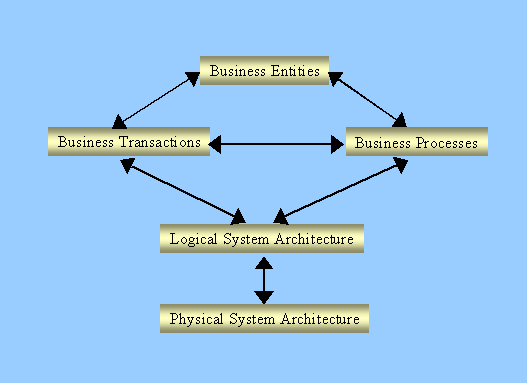
CS 601 - Project Supplement
I. Introduction. The overall project will relate to assessing the current and future needs for information systems in a business enterprise. In order to keep the project demands realistic it seems that each person should select one product line or product family on which to focus their attention. You should visualize yourself as the primary assistant to a VP for some business function, such as Marketing, Finance or even Information Systems. Another option is to see yourself as a primary decision-maker in a smaller enterprise. Or you could approach the project from the point of view of someone starting up a new business.
Your overall goal is to prepare for high level meetings associated with planning the information systems for the overall enterprise relative to this product family. What is the current state of affairs and what are your area's needs and the firm's needs?
II. Some Background on Models.
A model is any simplification of an event or series of events which appropriately correspond(s) to the event(s) or features we are studying. In addition you want to ensure that a model has the following attributes.In this project the model is a Business Model so the essential features are business features.
The model must also consider the data, so it is necessary to become familiar with data concepts. The easiest way to do this is to use them.
When working with data we will frequently use the following two terms
When viewed as the basis for a learning process it becomes apparent that data is a
resource, and specifically, data is an enterprise resource. Data must be managed independently of the business activities and consistent with a business plan or set of needs. Data can be viewed as a capital asset owned by the entire organization and should be managed for the benefit of the entire organization.Ownership of data includes such issues as
III. Business Environment Models.
In order to get a good grasp on an enterprise's information systems requirements it is important to understand the business. There are a large variety of approaches. I am going to present a hybrid approach that includes models from a variety of sources that I see as the most important components for this project.One very thorough approach that I will borrow from is to distinguish business entities, business transactions and business processes and develop detailed models associated with each of these. Then after these models are developed, the data designer should link these to models for the logical computer system architecture and the physical system architecture. The following diagram gives a picture of the overall relationships between the models. While we will not be concerned with constructing models for every aspect of this approach I think it is worthwhile to get an overall picture of what a very thorough approach would involve.

IV. Business Entity Models
. Regardless of how involved you get in actually creating a Business Entity Model for your project, I want to introduce the construct and give some examples.Some typical
business entities, though they vary according to the business, are customers, vehicles, competitors, employees, products, and supplies.An
entity is an archetype of a natural observable involved in any of the business activities or rules. That is, it is an activity, item or characteristic worthy of attention when discussing the enterprise.In order to understand the entity concept we also need to consider the concept of an occurrence or
instance of an entity. An entity instance is one single identifiable example of the observable or entity. An essential characteristic of an entity instance is the ability to identify distinct occurrences.The decision to regard something as an entity is as much a decision about what we can identify as it is a decision about what we regard as important.
Example 1.
If we are concerned with the effect of a flood we would not regard the drops of water as entity occurrences since we cannot distinguish each drop of water in the flood.Example 2.
If we sell oil or gasoline we do not regard each drop or gallon as entities. If we blend truckloads into the same storage tanks we do not consider individual shipments as entity instances. But we might consider each fuel grade as an entity instance if we keep them separate and hence identifiable.Example 3.
If we well candy bars or newspapers over the counter we would not view each customer as an entity instance since we would not keep records on the identity of each customer. Therefore there would be no "customer" entity. We might wish to distinguish between morning, afternoon and evening customers because we keep records about sales by time of day.Example 4.
Product lines are typically considered to be an entity instance. Each type of product is a single entity; each individual item is an entity occurrence.Example 5.
A customer is an entity if each single customer is considered an entity occurrence, which implies we know or can identify each customer.The entity instances we study have descriptive identifiers or characteristics usually called
states. These characteristics will differ between instances, but may be expected to vary over time for the same entity instance.Entity states are defined by the values of certain entity characteristics. As these characteristics change over time the entity is described as undergoing a
state change or state transition.The states of an entity are often described by an adjective.
Entities whose attributes can be altered by internal managerial or external environmental actions are termed
behavioral entities.We use the term Entity State to describe, and therefore increase understanding, of each of the behavioral responses that can be obtained as a result of different business actions.
Obviously we cannot know all possible entity states. Furthermore, even if we could identify them all we could not manage them. We need to focus on determining those that are most important so that we can encourage or discourage them.
Some Definitions.
For example, if it is important to your business situation to consider the fleet of company cars, then an example of an initial state is when it is first acquired. Call this vehicle acquisition. In this situation, a final state would likely be when the vehicle leaves the enterprise by being sold. Other transition states would be an active service state and a repair state. Obviously, there are several other obvious states such as status and totaled.
An
entity transition diagram is a semiotic model in which circles represent entity states and directed arcs represent business or event actions. This definition requires thatA
life cycle model consists ofAn example of an entity life cycle model for recruiting and hiring is given below.
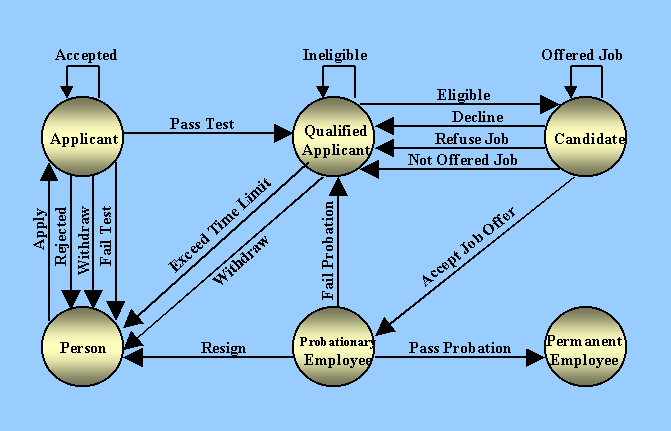
It will usually be the case that the states of an entity transition diagram will relate to the states in which a customer can be classified during their interaction with a system. The changes of state occur because of some action by the customer or the system. The following diagram is a relatively simple representation of an online customer's shopping experience with a web.
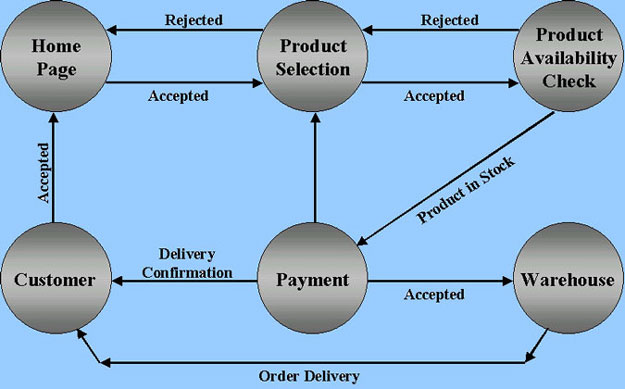
Our goal is the ability to identify, and/or define the data that provides us with the capability to manage in accordance with strategic principles as efficiently as possible.
Some Definitions.
VI. Business Information Models
.The purpose of a Business Information Diagram is to identify organizational structures and their interactions.
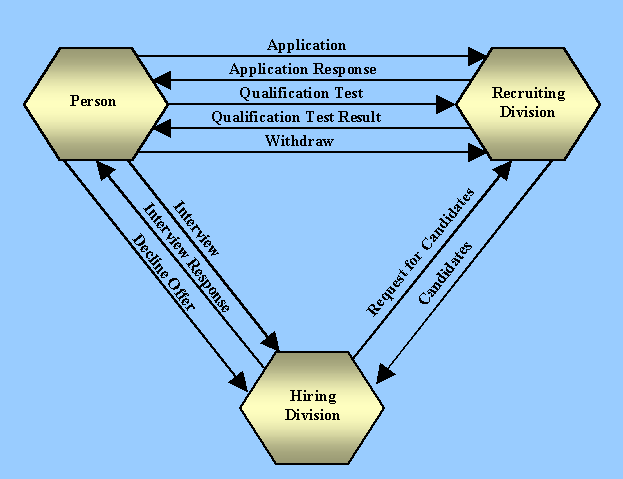
Do not confuse a business information diagram with a data flow diagram. A business information diagram is concerned with identifications and relationships and does not consider processing or how to construct, alter or manipulate data. In order to construct a complete
business information model one must include a definition of each business entity and business transaction on or with the diagram.VII. System Architecture Models
. While there are a number of other models that we could include for modeling the overall business environment, since each project should focus on one product family with its concomitant strategies we can narrow the selection. One of the important things you should do is construct models that layout the processing requirements of your important business entities, typically customers and products.One of the most widely used diagrams is typically called a
data flow diagram. Rectangles represent entities, which are originators or receivers of information located outside the boundaries of the system being modeled. Rounded edged rectangles represent a process, which represent transformations of data. A data card represents data stores or data classes, which are either manual or automated inventories of data. The arcs represent data flows. The arcs show the movement of data between entities, processes and data stores.The following is a data flow diagram for a student registering for classes at a school where the student can either use a computer to register or interact with trained personnel to register for classes.
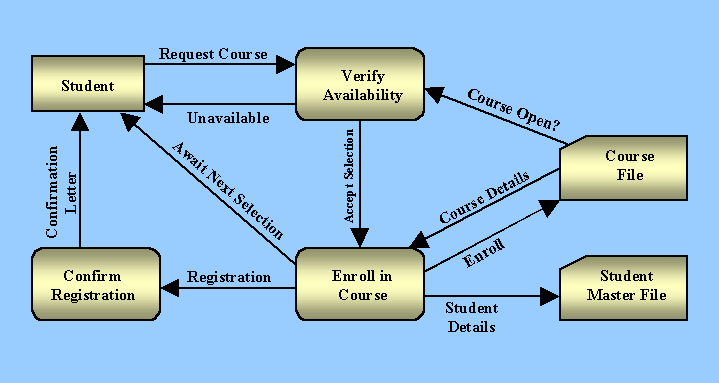
A much more complicated data flow diagram that relates to scheduling patients at a medical clinic has also been included. Hopefully, it is obvious that all four data sources are required in order to actuate a daily appointment.
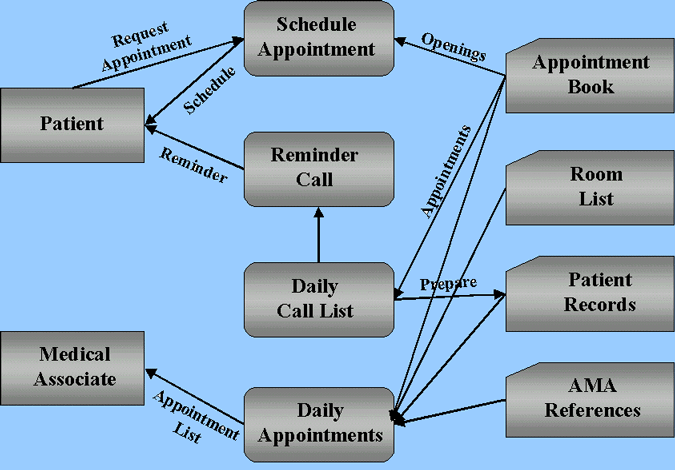
It is usually helpful to write out a concise narrative of how the entity interacts with the system and what information should be available to make the process work.
VIII. Milestones
. This project has several milestones. The primary purpose of a milestone is to provide feedback to you so that you may make adjustments before the final submission of the project. Only the final project submission will receive a number grade.Remember that the project has to do with the influence of information systems on the overall ability of a firm to meet its goals.
Milestone 1.
For the first milestone you are required to identify, in narrative form, the environment and strategic scope of concern of an organization or business of your selection relative to a particular product family. Using slightly different words, this means that you should identify a business environment and strategic goals for a system that you will work with. You should also identify relevant business rules as much as possible. Remember this is a course in information systems so you want to make sure and start developing how these strategies relate to information systems.Milestone 2.
For the second milestone you shouldProject Completion.
This step of the project is probably the most difficult to describe because it can vary between projects. But here are some guidelines
Notes and Suggestions.
This project is primarily concerned with developing an overall framework for information systems based on strategic issues in a business environment. I think it is worthwhile to explicitly note that his involves several difficulties, probably among many others.In spite of these problems, there is a synergy involved in the completion of this type of project. What will happen is that your understanding and awareness of organizational issues such as strategic planning and information systems should improve as you work to develop this project. This will be the case even if none of these concepts have much meaning to you at the beginning of the project. So it should be worthwhile to work your way through this.
Some Problems.